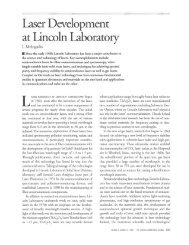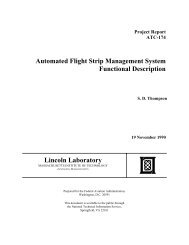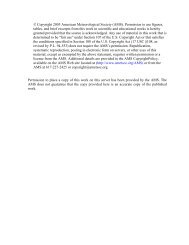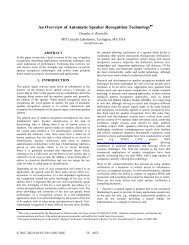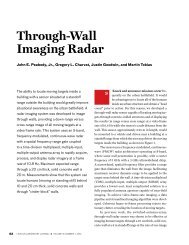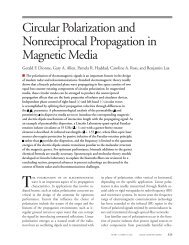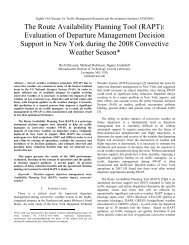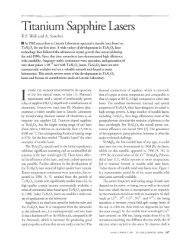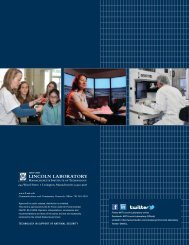Division and Group Summaries Career Opportunities - MIT Lincoln ...
Division and Group Summaries Career Opportunities - MIT Lincoln ...
Division and Group Summaries Career Opportunities - MIT Lincoln ...
Create successful ePaper yourself
Turn your PDF publications into a flip-book with our unique Google optimized e-Paper software.
5<br />
<strong>Division</strong> <strong>and</strong> <strong>Group</strong> <strong>Summaries</strong><br />
<strong>Group</strong> 45 – Advanced Capabilities <strong>and</strong> Systems<br />
The Advanced Capabilities <strong>and</strong> Systems <strong>Group</strong> provides assessments of novel technologies <strong>and</strong><br />
system concepts in solution of significant defense <strong>and</strong> intelligence needs <strong>and</strong>, where appropriate,<br />
rapidly develops prototype solutions to demonstrate concepts or provide fieldable capability. To<br />
accomplish these goals, the group taps Laboratory-wide knowledge <strong>and</strong> couples this with the<br />
group’s strong systems analysis expertise. Modeling, often supported by quick measurements <strong>and</strong><br />
tests, is used to evaluate the feasibility of proposed solutions to problems, as well as to creatively<br />
develop new alternatives. Products of this assessment process include briefings <strong>and</strong> proposals for<br />
follow-on development efforts. Where a rapid capability is sought, the group often leads multigroup<br />
coalitions in the execution of these efforts.<br />
<strong>Group</strong> 46—Advanced System Concepts<br />
The Advanced System Concepts <strong>Group</strong> conducts systems analysis on a broad range of problems<br />
related to surface surveillance, force protection, <strong>and</strong> homel<strong>and</strong> defense. Activities include sensor<br />
<strong>and</strong> system modeling, mission requirements analysis, <strong>and</strong> architecture development. A variety of<br />
technologies are examined, including radar, optical, acoustic, biological, <strong>and</strong> chemical sensors.<br />
Modeling <strong>and</strong> the analysis of field measurements are used to quantify the ability of current <strong>and</strong><br />
proposed technology to meet mission requirements. This work includes analysis, algorithm<br />
development, <strong>and</strong> field testing.<br />
<strong>Group</strong> 47—Biodefense Systems<br />
The Biodefense Systems <strong>Group</strong> works on the design, development, <strong>and</strong> demonstration of<br />
bioagent <strong>and</strong> other hazardous material sensing <strong>and</strong> protection systems that detect <strong>and</strong> warn<br />
of the presence of organisms of concern in air, water, or environmental samples. The goal of<br />
the sensing component is to increase the speed <strong>and</strong> accuracy of current detection methods by<br />
improving existing systems or inventing new sensors. The goal of the protection aspect is to<br />
develop methods <strong>and</strong> systems for mitigating the effect of a bioagent attack on buildings or people<br />
(civilian <strong>and</strong> military). Research from this group encompasses algorithm development <strong>and</strong> signal<br />
processing for integration of data from multiple sensors, deployment <strong>and</strong> modeling of existing<br />
sensors, hardware design for next-generation sensors, applied research in surface chemistry for<br />
organism concentration or detection, <strong>and</strong> applied biology research to rapidly purify organisms or<br />
their DNA or RNA from complex matrices. Systems analyses, including threat <strong>and</strong> vulnerability<br />
assessment, modeling of attacks <strong>and</strong> defenses, <strong>and</strong> cost/benefit assessment, are performed<br />
to optimize the design of biological or chemical defense systems. The backgrounds of the<br />
researchers in this group span a wide range of disciplines that includes engineering (electrical,<br />
mechanical, chemical, <strong>and</strong> biomedical), computer science, physics, mathematics, chemistry, <strong>and</strong><br />
biology.



